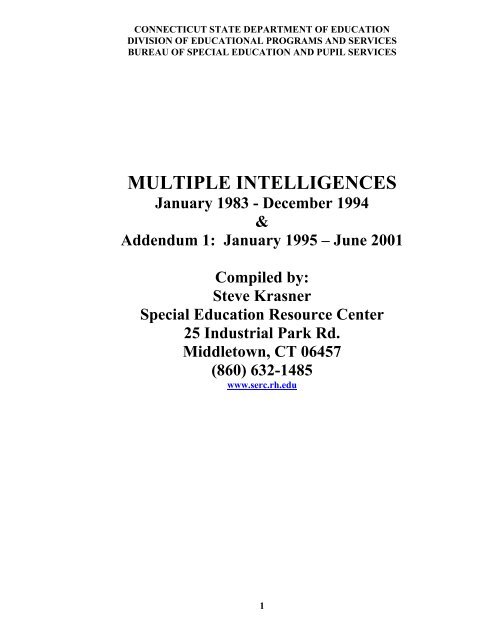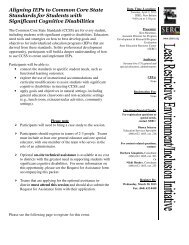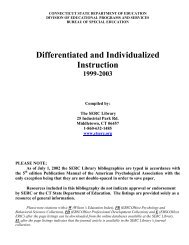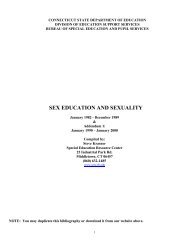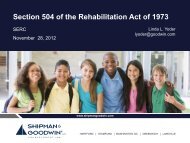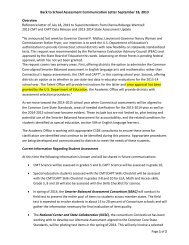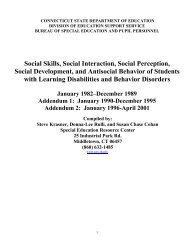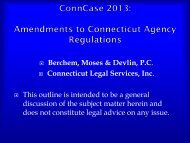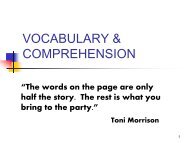MULTIPLE INTELLIGENCES - The State Education Resource Center
MULTIPLE INTELLIGENCES - The State Education Resource Center
MULTIPLE INTELLIGENCES - The State Education Resource Center
You also want an ePaper? Increase the reach of your titles
YUMPU automatically turns print PDFs into web optimized ePapers that Google loves.
Ellison, L. (1992). Using multiple intelligences to set goals. <strong>Education</strong>al Leadership, 50(2),69-72.Fernie, D.E. (1992). Profile: Howard Gardner. Language Arts, 69, 220-227.Gardner, H. (1987). Beyond the IQ: <strong>Education</strong> and human development. Developing the spectrumof human intelligences. Harvard <strong>Education</strong>al Review, 57, 187-193.Gardner, H. (1993). Creating minds: An anatomy of creativity seen through the lives ofFreud, Einstein, Picasso, Stravinsky, Eliot, Graham, and Gandhi. New York, NY: BasicBooks.(153.350922 GAR – Book)Gardner, H. (1983). Frames of mind: <strong>The</strong> theory of multiple intelligences. New York: BasicBooks. (153. GAR - Book)Gardner, H (1994). Intelligences in theory and practice: A response to Elliot W. Eisner, Robert J.Sternberg, and Henry M. Levin. Teachers College Record, 95, 576-583.Gardner, H. (1993). Multiple intelligences: <strong>The</strong> theory in practice. New York: BasicBooks, ADivision of HarperCollins Publishers. (370.1523 GAR - Book)Gardner, H. (1987). <strong>The</strong> theory of multiple intelligences. Annals of Dyslexia, 37, 19-35.Gursky, D. (1991). <strong>The</strong> unschooled mind. Teacher Magazine, 3(3), 38-44.Guskin, S.L., Peng, C.Y.J., & Majd-Jabbari, M. (1988). Teachers’ perceptions of giftedness.Gifted Child Quarterly, 32, 216-221.Guskin, S.L., Peng, C.Y.J., & Simon, M. (1992). Do teachers react to ”multiple intelligences”?Effects of teachers’ stereotypes on judgments and expectancies for students with diverse patterns ofgiftedness/talent. Gifted Child Quarterly, 36, 32-37.Hebert, E.A. (1992). Portfolios invite reflection--from students and staff. <strong>Education</strong>alLeadership, 49(8), 58-61.Hoerr, T.R. (1992). How our school applied multiple intelligences theory. <strong>Education</strong>alLeadership, 50(2), 67-68.Hoerr, T.R (1994). How the New City School applies the multiple intelligences. <strong>Education</strong>alLeadership, 52(3), 29-33.Kovalik, S. (1994). Brain compatible learning: Videotape program 1: A model for a braincompatible classroom/Videotape program 2: <strong>The</strong> ITI model at work. Salt Lake City, UT: VideoJournal of <strong>Education</strong>. (IE 370.1523 KOV - Inservice <strong>Education</strong>/Videotapes)Lazear, D. (1991). Seven ways of knowing: Teaching for multiple intelligences. Palatine, IL:IRI Skylight. (IM 370.1523 LAZ - Instructional Material/Book)Lee, P.A. (1994). To dance ones understanding. <strong>Education</strong>al Leadership, 51(5), 81-83.3
Leibowitz, D.G., & Starnes, W.T. (1993). Unmasking young children’s gifts. Gifted Child Today,16(5), 28-32.Levin, H.M. (1994). Commentary: Multiple intelligence theory and everyday practices. TeachersCollege Record, 95, 570-575.Maker, C.J., Nielson, A.B., & Rogers, J.A. (1994). Giftedness, diversity, and problem-solving.Teaching Exceptional Children, 27(1), 4-19.Matthews, D. (1988). Gardner’s multiple intelligence theory: An evaluation of relevant researchliterature and a consideration of its application to gifted education. Roeper Review, 11, 100-104.Miller, L. (1990). <strong>The</strong> roles of language and learning in the development of literacy. Topics inLanguage Disorders, 10(2), 1-24.O’Connor, A.T., & Callahan-Young, S. (1994). Seven windows to a child’s world: 100 ideasfor the multiple intelligences classroom. Palatine, IL: IRI Skylight.(IM 370.1523 OCO - Instructional Material/Book)Samples, B. (1992). Using learning modalities to celebrate intelligence. <strong>Education</strong>al Leadership,50(2), 62-66.Siegel, J., & Shaughnessy, M.F. (1994). Educating for understanding: An interview with HowardGardner. Phi Delta Kappan, 75, 563-566.Sternberg, R.J (1994). Commentary: Reforming school reform: Comments on MultipleIntelligences: <strong>The</strong> <strong>The</strong>ory in Practice. Teachers College Record, 95, 561-569.Wallach, C., & Callahan, S. (1994). <strong>The</strong> 1st grade plant museum. <strong>Education</strong>al Leadership,52(3), 32-34.4
ADDENDUM I:<strong>MULTIPLE</strong> <strong>INTELLIGENCES</strong>January 1995 – June 2001Adams, T.L. (2000-2001). Helping children learn mathematics through multiple intelligences andstandards for school mathematics. Childhood <strong>Education</strong>, 77, 86-92.Anderson, A., & Weber, E. (1997). A multiple intelligence approach to healthy active living inhigh school. Journal of Physical <strong>Education</strong>, Recreation and Dance, 68(4), 57-62.Armstrong, T. (1998). Awakening genius in the classroom. Alexandria, VA: Association forSupervision and Curriculum Development. (370.1523 ARM – Book)Armstrong, T. (1997). Multiple intelligences: Discovering the giftedness in ALL. Port Chester,NY: National Professional <strong>Resource</strong>s. (IE 370.1523 ARM - Inservice <strong>Education</strong>/Videotape)Armstrong, T. (2000). Multiple intelligences in the classroom (2 nd edition). Alexandria, VA:Association for Supervision and Curriculum Development. (370.1523 ARM – Book)Barkman, R. (1999). Science through multiple intelligences: Patterns that inspire inquiry.Tuscon, AZ: Zephyr Press. (IM 508.071 BAR – Instructional Material/Book)Barnett, I.A.P. (1999). Multiple intelligences: Teaching kids the way they learn, grade 1.Torrance, CA: Frank Schaffer Publications. (IM 370.1523 BAR – InstructionalMaterial/Workbook)Beamon, G.W. (1997). Sparking the thinking of students, ages 10-14: Strategies for teachers.Thousand Oaks, CA: Corwin Press. (372.242 BEA – Book)Beck, J. (1999). Recognizing hidden intelligences. Schools in the Middle, 9(1), 13-16.Bellanca, J.A., & Brown, E.F. (1998). Active learning handbook for the muiltiple intelligencesclassroom (book review). Roeper Review, 20 234.Bellanca, J.A., & Schack, G.D. (1998). Active learning handbook for the multiple intelligencesclassroom (book review). Roeper Review, 20, 303-304.Berman, S., & Fields, J. (1998). A multiple intelligences road to a quality classroom (book review).Roeper Review, 20, 235-236.Black, S. (1998). How are you smart? American School Board Journal, 185(10), 26-29.Black, S. (1995). Just do it. Executive Educator, 17(4), 33-36.5
Gardner, H. (1995). How are kids smart? Multiple intelligences in the classroom,administrators’ version. Port Chester, NY: National Professional <strong>Resource</strong>s.(IE 370.1523 GAR - Inservice <strong>Education</strong>/Videotape)Gardner, H. (1997). Multiple intelligences as a partner in school improvement. <strong>Education</strong>alLeadership, 55(1), 20-21.Gardner, H. (1996). Probing more deeply into the theory of multiple intelligences. NASSPBulletin, 80(583), 1-7.Gardner, H. (1995). Reflections on multiple intelligences: Myths and messages. Phi DeltaKappan, 77, 200-203, 206-209.Gardner, H., & High School Magazine. (1998). An interview with Howard Gardner. High SchoolMazazine, 5(3), 50-53.Gardner, H., & Lazear, D (1995). Multiple intelligences: Developing intelligences for greaterachievement. Videotape program 1: Discovering the seven intelligences/Videotape program 2:Enriching students’ intelligences in the classroom. Salt Lake City, UT: VideoJournal of <strong>Education</strong>. (IE 370.1523 GAR - Inservice <strong>Education</strong>/Videotape)Gauld, J.W. (1996). Meeting each student’s unique potential: One approach to education. NASSPBulletin, 80(583), 43-54Gibson, B.P., & Govendo, B.L. (1999). Encouraging constructive behavior in middle schoolclassrooms: A multiple-intelligences approach. Intervention in School and Clinic, 35, 16-21.Glasgow, J.N. (1997). Let’s plan it, map it, and show it! A dream vacation. Journal ofAdolescent and Adult Literacy, 40, 456-467.Glasgow, J.N., & Bush, M. (1996). Students use their multiple intelligences to develop promotionalmagazines for local businesses. Journal of Adolescent and Adult Literacy, 39, 638-649.Glik, D.C., Stone, K.M., & McNeil, J.D. (1997). A multidisciplinary curriculum for 11- to 13-yearolds:Immunization, plus! Journal of School Health, 67, 256-258.Glock, J., Wertz, S., & Meyer, M. (1999). Discovering the naturalistic intelligence: Science inthe school yard. Tucson, AZ: Zephryr Press. (IM 372.35044 GLO – Instructional Material/Book)Greenhawk, J. (1997). Multiple intelligences meet standards. <strong>Education</strong>al Leadership, 55(1),62-64.Greenwald, N.L. (1998). Songs the dinosaur sang! Gifted Child Today Magazine, 21(6), 14-17,Griffith, S.C. (1999). Multiple intelligences: Teaching kids the way they learn, grade 1.Torrance, CA: Frank Schaffer Publications, Inc.IM 370.1523 GRI – Instructional Material/Workbook)8
Guild, P.B. (1997). Where do the learning theories overlap. <strong>Education</strong>al Leadership, 55(1),30-31.Guild, P.B., & Chock-Eng, S. (1998). Multiple intelligence, learning styles, brain-based education:Where do the messages overlap? Schools in the Middle, 7(4), 38-40.Gusman, J. (1998). Multiple intelligences and the second language learner. Port Chester, NY:National Professional <strong>Resource</strong>s. (IE 370.1523 GUS - Inservice <strong>Education</strong>/Videotape)Hall, M.C. (1999). Multiple intelligences: Teaching kids the way they learn, grade 4.Torrance, CA: Frank Schaffer Publications, Inc.IM 370.1523 GRI – Instructional Material/Workbook)Hatch, T. (1997). Getting specific about multiple intelligences. <strong>Education</strong>al Leadership, 54(6),26-29.Hearne, D., & Stone, S. (1995). Multiple intelligences and underachievement: Lessons fromindividuals with learning disabilities. Journal of Learning Disabilities, 28, 439-448.Hebert, E.A. (1998). Lessons learned about student portfolios. Phi Delta Kappan, 79, 583-585.Hoerr, T. (1996). Apply the theory, avoid the traps. Multiple intelligences update. Learning,25(1), 69-71.Hoerr, T.R. (2000). Becoming a multiple intelligence school. Alexandria, VA: Association forSupervision and Curriculum Development. (370.152 HOE – Book)Hoerr, T.R. (2000). Becoming a multiple intelligence school. Alexandria, VA: Association forSupervision and Curriculum Development. (IE 370.152 HOE – Inservice <strong>Education</strong>/Videotape)Hoerr, T.R. (1997). Call of the wildlife (naturalistic intelligence). Learning, 26(2), 73-75.Hoerr, T.R. (1996). Focusing on the personal intelligences as a basis for success. NASSP Bulletin,80(583), 36-42.Hoerr, T.R. (1997). Frog ballets and musical fractions. <strong>Education</strong>al Leadership, 55(1),43-46.Hoerr, T.R. (1996). Introducing the theory of multiple intelligences. NASSP Bulletin, 80(583),8-10.Hoffman, B.G., & Thoman, K. (1999). Multiple intelligences: Teaching kids the way theylearn, grade 3. Torrance, CA: Frank Schaffer Publications, Inc.IM 370.1523 GRI – Instructional Material/Workbook)Jordan, S.E. (1996). Multiple intelligences: Seven keys to opening closed minds. NASSP Bulletin,80(583), 29-35.9
Kagan, S., & Kagan, M. (1998). Multiple intelligences: <strong>The</strong> complete MI book. San Clemente,CA: Kagan Cooperative Learning. (IM 370.1523 KAG – Instructional Material/Book)Knodt, J.S. (1997). A think talk cultivates kids. <strong>Education</strong>al Leadership, 55(1), 35-37.Lambert, W.E. (1997). From Crockett to Tubman: Investigating historical perspectives.<strong>Education</strong>al Leadership, 55(1), 51-54.Latham, A.S. (1997). Quantifying MI’s gains. <strong>Education</strong>al Leadership, 55(1), 84-85.Lazear, D. (1999). Eight ways of knowing: Teaching for multiple intelligences. ArlingtonHeights, IL: SkyLight Training and Publishing, Inc.(IM 370.1523 LAZ – Instructional Materials/Book)Lazear, D. (1999). Eight ways of teaching: <strong>The</strong> artistry of teaching with multiple intelligences.Arlington Heights, IL: SkyLight Training and Publishing, Inc.(IM 370.1523 LAZ – Instructional Materials/Book)Lazear, D. (1995). MI in action: Your school and the multiple intelligences: 1. Getting thepicture: An overview. Tucson, AZ: Zephyr Press.(IE 370.1523 LAZ 1 - Inservice <strong>Education</strong>/Videotape)Lazear, D. (1995). MI in action: Your school and the multiple intelligences: 2. A creative art:Teaching MI in the elementary grades. Tucson, AZ: Zephyr Press.(IE 370.1523 LAZ 2 - Inservice <strong>Education</strong>/Videotape)Lazear, D. (1995). MI in action: Your school and the multiple intelligences: 3. Tuning in thelearner: MI in the middle and high school grades. Tucson, AZ: Zephyr Press.(IE 370.1523 LAZ 3 - Inservice <strong>Education</strong>/Videotape)Lazear, D. (1995). MI in action: Your school and the multiple intelligences: 4. Testing forsuccess: MI assessment. Tucson, AZ: Zephyr Press.(IE 370.1523 LAZ 4 - Inservice <strong>Education</strong>/Videotape)Lazear, D. (1995). MI in action: Your school and the multiple intelligences: 5. Miss Ballou,where are you? An MI guide for parents. Tucson, AZ: Zephyr Press.(IE 370.1523 LAZ 5 - Inservice <strong>Education</strong>/Videotape))Lazear, D. (1999). Multiple intelligence approaches to assessment: Solving the assessmentconundrum (Revised edition). Tucson, AZ: Zephyr Press.(IM 370.1523 LAZ – Instructional Material/Book)Lindquist, T. (1998). Stretch kids’ multiple intelligences the Japanese way! Instructor, 107(7),42-43.Maker, C.J., & King, M.A. (1996). Nurturing giftedness in young children. Reston, VA:Council for Exceptional Children. (ED 398 665 - Microfiche, 64 pages)10
Maker, C.J., Rogers, J.A., Nielson, A.B., & Bauerle, P.R. (1996). Multiple intelligences, problemsolving, and diversity in the general classroom. Journal for the <strong>Education</strong> of the Gifted, 19, 437-460.Merrefield, G.E. (1997). Three billy goats and Gardner. <strong>Education</strong>al Leadership, 55(1),58-61.Meyer, M. (1997). <strong>The</strong> GREENing of learning: Using the eighth intelligence. <strong>Education</strong>alLeadership, 55(1), 32-34.Morgan, H. (1996). An analysis of Gardner’s theory of multiple intelligence. Roeper Review,18, 263-269.Nelson, K. (1995). Nurturing kids’ seven ways of being smart. Instructor, 105(1), 26-30, 34.Newbold, C.T. (1999). Multiple intelligences and the artistic imagination: A case study of Einsteinand Picasso. Clearing House, 72, 153-155.Nicholson-Nelson, K. (1998). Literacy activities that tap kids’ multiple intelligences.. Instructor,107(5), 65-67.Patterson, M.N. (1997). Every body can learn: Engaging the bodily-kinesthetic intelligence inthe everyday classroom. Tuscon, AZ: Zephyr Press. (371.39 PAT – Book)Plucker, J.A. (1998). Finding talent in quiet places. NASSP Bulletin, 82(595), 1-3.Plucker, J.A., Callahana, C.M., & Tomchin, E.M. (1996). Wherefore art thou, multipleintelligences? Alternative assessments for identifying talent in ethnically diverse and low incomestudents. Gifted Child Quarterly, 40, 81-92.Pool, C.R. (1997). Web wonders. <strong>Education</strong>al Leadership, 55(1), 86-87.Prior, J.O. (1999). Multiple intelligences: Teaching kids the way they learn, grade 5. Torrance,CA: Frank Schaffer Publications, Inc. (IM 370.1523 PRI – Instructional Material/Workbook)Pyryt, M.C. (1999). Putting the “g” back into gifted education. Understanding Our Gifted,12(10, 16-18.Reid, C., & Romanoff, B. (1997). Using multiple intelligence theory to identify gifted children.<strong>Education</strong>al Leadership, 55(1), 71-74.Reid, C., Udall, A., Romanoff, B., & Algozzine, B. (1999). Comparison of traditional and problemsolving assessment criteria. Gifted Child Quarterly, 43, 252-264.Reiff, J.C (1996). Bridging home and school through multiple intelligences. Childhood<strong>Education</strong>, 72, 164-166.Reiff, J.C. (1997). Multiple intelligences, culture and equitable learning. Childhood <strong>Education</strong>,73, 301-304.Richardson, D. (1997). Mapping Venus. Science Teacher, 64(8), 22-24.11
Roth, K. (1998). <strong>The</strong> naturalist intelligence: An introduction to Gardner’s eighth intelligence.Arlington Heights, IL: IRI/Skylight Training and Publishing, Inc. (370.1523 ROT – Book)Rourke, J. (Ed.). (1998). An interview with Howard Gardner. High School Magazine, 5(1),50-53.Sarouphim, K.M. (1999). Discovering multiple intelligences through a performance-basedassessment: Consistency with independent ratings. Exceptional Children, 65, 151-161.Sarophim, K.M. (2000). Internal structure of DISCOVER: A performance-based assessment.Journal for the <strong>Education</strong> of the Gifted, 23, 314-327.Scherer, M. (1999). <strong>The</strong> understanding pathway: A conversation with Howard Gardner.<strong>Education</strong>al Leadership, 57(3), 12-16.Silver, H., Strong, R., & Perini, M. (1997). Integrating learning styles and multiple intelligences.<strong>Education</strong>al Leadership, 55(1), 22-27.Silver, F.H., Strong, R.W., & Perini, M.J. (2000). So each may learn: Integrating learning stylesand multiple intelligences. Alexandria, VA: Association for Supervision and CurriculumDevelopment. (370.152 SIL – Book)Smargorinsky, P. (1996). Multiple intelligences, multiple means of composing: An alternative wayof thinking about learning. NASSP Bulletin, 80(583), 11-17.Smerechansaky-Metzger, J.A. (1995). <strong>The</strong> quest for multiple intelligences. Gifted Child TodayMagazine, 18(3), 12-15.Soares, L.M. (1998). Structure, content, and process in teacher training: <strong>The</strong> relevance ofCopernicus, Gardner, and Dewey. Clearing House, 71, 217-220.Steele, A.L. (1999). Multiple intelligences: Teaching kids the way they learn, grade 2.Torrance, CA: Frank Schaffer Publications. (IM 370.1523 STE – Instructional Material/Workbook)Sternberg, R.J. (1996). IQ counts, but what really counts is successful intelligence. NASSPBulletin, 80(583), 18-23.Stuart, A. (1997). Student-centered learning. Learning, 26(2), 53-55.Summey, H.K., & Strahan, D.B. (1997). An exploratory study of mainstreamed seventh graders’perceptions of an inclusive approach to instruction. Remedial and Special <strong>Education</strong>, 18, 36-45.Sweet, S.S. (1998). A lesson learned about multiple intelligences. <strong>Education</strong>al Leadership, 56(3),50-51.Teele, S. (1996). Redesigning the educational system to enable all students to succeed. NASSPBulletin, 80(583), 65-75.12
Tippins, D.J., Williamson, R., & Lamb, V. (1999). A fishy adventure. Science and Children,36(5), 16-20.Torff, B. (Ed.). (1997). Multiple intelligences and assessment: A collection of articles.Arlington Heights, MA: IRI/Skylight Training and Publishing, Inc. (370.1523 TOR – Book)Vialle, W. (1997). In Australia: Multiple intelligences in multiple settings. <strong>Education</strong>alLeadership, 55(1), 65-69.Wahl, M. (1997). Math for humans: Teaching math through 7 intelligences. Waco, TX:Prufrock Press. (IM 370.1523 WAH – Instructional Material/Book)Waldman, N.J. (1999). Multiple intelligences; Teaching kids the way they learn, grade 6.Torrance, CA: Frank Schaffer Publications.(IM 370 1523 WAL – Instructional Material/Workbook)Weber, E. (1996). Creative communities in high school: An interactive learning and teachingapproach. NASSP Bulletin, 80(583), 76-86.Weber, E. (1999). Uniting to introduce multiple intelligences teaching aproaches (MITA). NASSPBulletin, 83(604), 57-68.,White, D.A., & Breen, M. (1998). Edutainment: Gifted education and the perils of misusingmultiple intelligences. Gifted Child Today Magazine, 21(2), 12-14,. 16-17.Willis, J.K., & Johnson, A.N. (2001). Multiply with MI: Using multiple intelligences to masterMultiplication. Teaching Children Mathematics, 7, 260-269.Witherell, N.L. (2000). Promoting understanding: Teaching literacy through the arts. <strong>Education</strong>alHorizons, 78, 179-183.13


